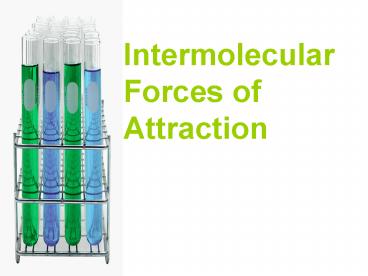Intermolecular Forces of Attraction - PowerPoint PPT Presentation
1 / 14
Title:
Intermolecular Forces of Attraction
Description:
Positive of one molecule attracts the negative of another. A Short Visual ... Strongly electronegative elements attract electrons so strongly that the ... – PowerPoint PPT presentation
Number of Views:53
Avg rating:3.0/5.0
Title: Intermolecular Forces of Attraction
1
Intermolecular Forces of Attraction
2
Intermolecular Forces of Attraction
- Three weak forces
- London Dispersion
- Dipole-Dipole
- Hydrogen Bonding
- One strong force (not technically an IMF, but an
actual bond!) - Ionic
3
London Dispersion
- Weakest of the weak intermolecular forces
- Caused by random and temporary movement of
electrons
- Short-lived, temporary force
- More electrons greater attractions
4
A Short Visual
- Three Molecules
- One molecule has a temporary imbalance in
electrons - Each molecule responds to that imbalance
5
Dipole-Dipole
- Still a very weak force, but stronger than London
Dispersion
- Permanent polar molecule has one positive and one
negative side
- Positive of one molecule attracts the negative of
another
6
A Short Visual
- One end of a molecule is permanently positive and
one end is permanently negative - Opposites attract
d
d
d-
d-
7
Another Short Visual
- A quick visual of what this might look like
- Notice there is not a regular pattern of the
molecules - the attraction is not strong enough
to hold the molecules in a fixed position.
8
(No Transcript)
9
Hydrogen Bonding
- A weak force of attraction, but strongest
compared to the previous two (London dispersion
and dipole-dipole) - Occurs with only the most electronegative
elements N, O, and F. - Strongly electronegative elements attract
electrons so strongly that the molecule becomes
very polar
10
Hydrogen Bonding
- The non-bonding pairs of electrons on the N, O,
or F are strongly attracted to the highly
positive H on another molecule.
- A quarter bond or half bond is formed between
the H and the pair of electrons, resulting in a
much stronger force than the previous forces.
- Requirements (both are necessary!)
- H bonded to N, O, F
- Non-bonded pair of electrons on the N, O, or F
11
A Short Visual
d-
- The very polar molecule has a very negative end
and a very positive end.
d-
d
- The negative electron pairs are attracted to the
positive hydrogen.
d
12
Yet Another Visual
- Here is an example of hydrogen bonding at work!
- Notice how the positive hydrogens are attracted
to the negative electron pairs on the oxygen!
13
Ionic
- NOT an intermolecular force of attraction!
- Actual bonds are formed between molecules forming
a crystal lattice (or network) of atoms. - Attractive forces between positive and negative
ions are as strong between molecules as within
molecules.
14
A Short Visual
- Na and Cl- ions are attracted to each other
because opposite charges attract! - A network of positive/negative alternating
charges begins to form.































